A trek of 4,000 miles between Alaska and Pennsylvania is a long trip even in three planes with today’s technology, observed Lauren Peters, days after the University of California, Davis, doctoral student and her family made that journey. She and her two sons were returning her grandmother’s aunt to her native Aleut island, St. Paul Island, on the Bering Sea, after her disinterment at the Carlisle Indian Industrial School in Carlisle, Pennsylvania.
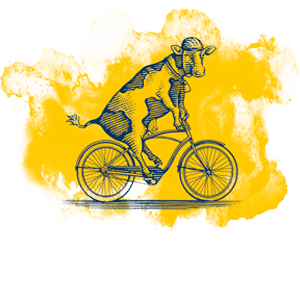
Imagine a place where creativity connects ideas from obvious to outlandish.
Find out how UC Davis outgrows the expected.
That ancestor, Sophia Tetoff, made a much more arduous journey as a 12-year-old girl. Orphaned in 1896, she was taken from the people and home she knew on St. Paul Island, Alaska, to live, eventually, at the Carlisle boarding school. Such a journey was estimated to take 25 days by boat and train at that time.
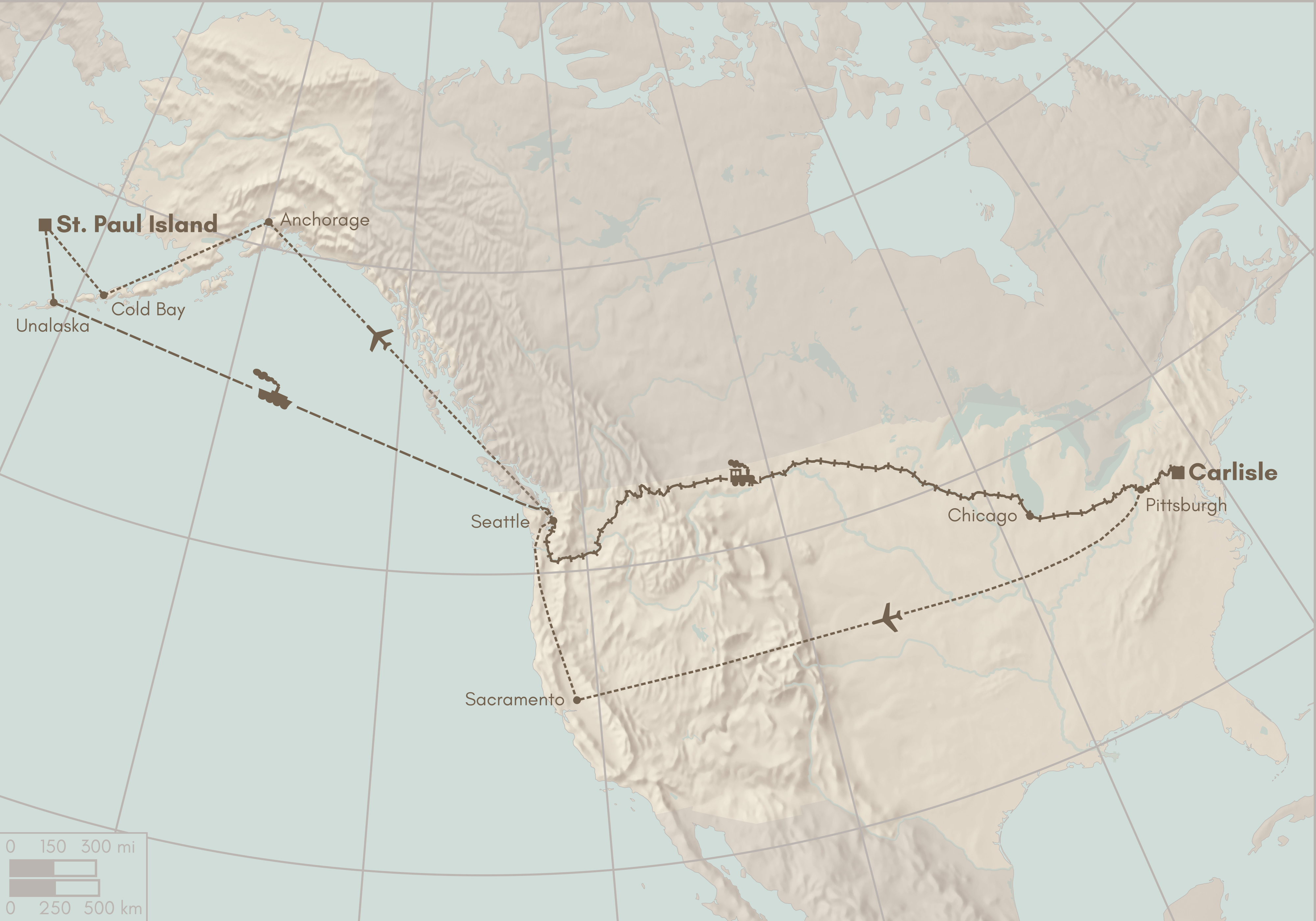

Five years after Sophia’s arrival at the school — her culture stripped from her as she was forced to work in the surrounding Carlisle community — she became ill with tuberculosis and died, a common fate for Natives at the time.
Native families
The Peterses are among the hundreds of Native families now learning about and retrieving their ancestors from school cemeteries in the United States and Canada. They are believed to be the first to return a Native child to Alaska.

Indian Boarding Schools and New Government Action
The Carlisle school was the first U.S.-government-sponsored boarding school of an estimated 500 similar schools in North America where Native children were brought to live, work, and often become servants to local townspeople in homes, businesses and farms from the late 1800s to the 1960s.
Deb Haaland, U.S. secretary of the Interior and the first Native American to serve as a Cabinet secretary, has pledged sustained action to “uncover the truth about the loss of human life, and the lasting consequences of the schools.” She created the Federal Indian Boarding School Initiative in June 2021 to investigate defunct residential boarding schools that housed Native American children under the Civilization Fund Act, passed by Congress in 1819. Haaland’s own great-grandfather was a survivor of the Carlisle Indian Industrial School.
When they traveled in June to the former Carlisle site, which now serves as the U.S. Army’s War College, they said they didn’t know what to expect.
“I was defensive of Sophia going into the process,” said Peters, who has formalized her years of research by pursuing a doctoral degree in Native American studies, focusing on the human rights of the dead. But she said she found the government and university officials present at the Carlisle cemetery were very respectful. “They were so compassionate and so gentle. They went way out of their way to get our trust, and [I can say] this is a safe place for other people to go get their children.”
The Peterses hope to lead other Natives home by their example. And they will, predicted Jessica Bissett Perea, UC Davis associate professor of Native American studies, who serves as Peters’ academic advisor.
“This project is truly groundbreaking and will serve as a model for other Native American communities who are grappling with how to bring their missing and murdered relatives home,” said Perea, who is herself Alaska Native, a Dena’ina scholar enrolled in the Knik tribe. She said she recruited Peters to the UC Davis program in doctoral studies based on the research, leadership and service she had carried out on Alaska Native history long before she entered the program in 2020, including serving on a national committee. Peters’ background, and the recent movement of the U.S. government to work with Native people to return the remains of Native children to their homes, put Peters in the right place at the right moment in time, Perea said.
“Lauren’s work contributes to and benefits from a confluence of significant local, national and international actions regarding Indigenous human rights.” — Jessica Bissett Perea
Bringing her home
Bringing Sophia to her resting place on St. Paul Island, home to about 500 people, was a labor of love for the whole Peters family.
Lauren Peters is an enrolled member of the Agdaagux Tribe in the Unangax Nation, also known at Aleut, in the land and waters that are now considered the Aleutian and Pribilof Islands of Alaska. St. Paul Island is one of the five Pribilof Islands located in the middle of the Bering Sea, 300 miles from the Alaska mainland and 800 miles from Anchorage — the closest urban center.
The journey to return Sophia to her remote island birthplace took about four years, starting with researching tribal and family history, and culminating this summer with Sophia’s return to the cemetery of the Russian Orthodox church where she was baptized.
Andrew Peters, a UC Davis biology student entering his senior year, flew with his mother to Pennsylvania for one of many services in June and July carried out to disinter the bodies found in graves at the school. The Peterses were the first to rematriate this summer from Carlisle. (While repatriation means a literal returning to the land of your ancestry, rematriation carries a deeper meaning of returning to a way of life, one that lives with reverence for nature, and is the term being used in this Native process.)
Army officials asked the Peters family how to care for Sophia’s remains. “I saw the Sioux were wrapping [bodies] in buffalo robes, so I asked for a fur seal pelt from St. Paul Island [which is well-known for seals],” Lauren Peters said.
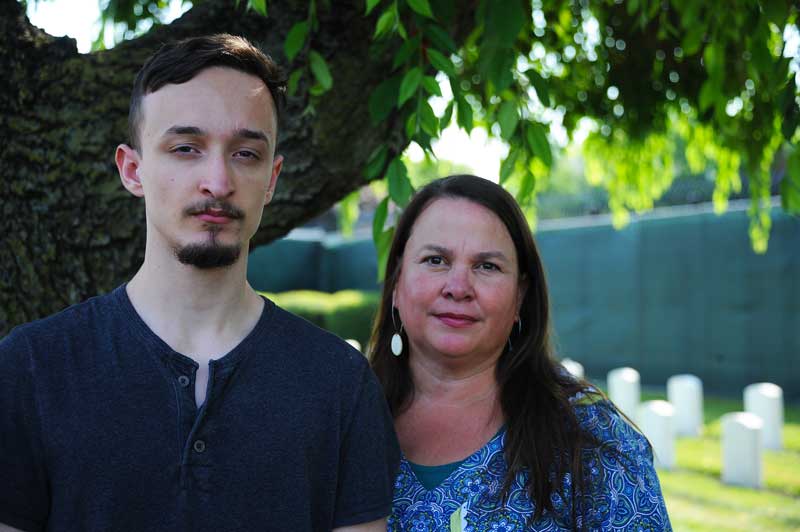
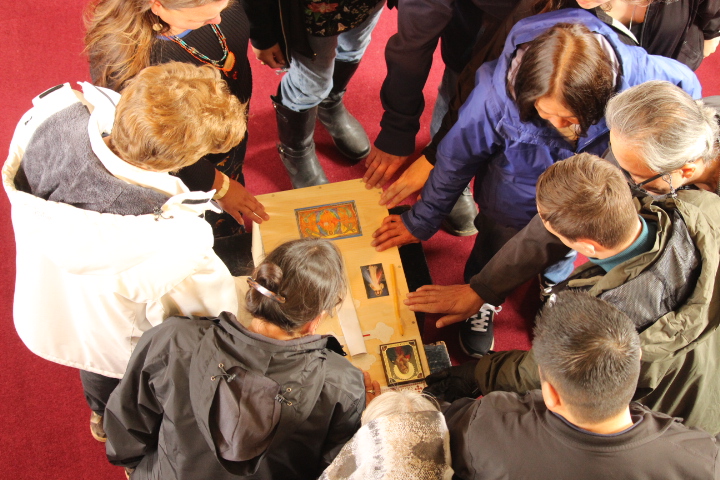
Andrew Peters, 21, served as a pallbearer at the school cemetery ceremony in June, wrapping Sophia’s remains with the pelt and putting her in a small coffin for transport to her home island.
At Lauren Peters’ request, her son witnessed the handling of Sophia’s body, administered by a team of about 20 anthropologists, archaeologists, volunteers and others in a tent on site, she said.
“I asked him to be her witness, to be her champion and to handle her remains respectfully,” she said, noting she considered the process too personal to do herself. “He really did the heavy lifting in what was a very personal, emotional experience.”
A Russian Orthodox priest presided over Sophia’s ceremony, honoring the religion she practiced on the once Russia-governed St. Paul Island.
The U.S. Army’s War College and Carlisle Barracks occupy what had been the school grounds, which became the burial grounds for Sophia and at least 188 other students. Sophia, just like each child buried there, Lauren Peters explained, was given at the Carlisle transfer ceremony in June a U.S. flag and some coins from Arlington Cemetery, much in the tradition of a U.S. soldier’s burial.
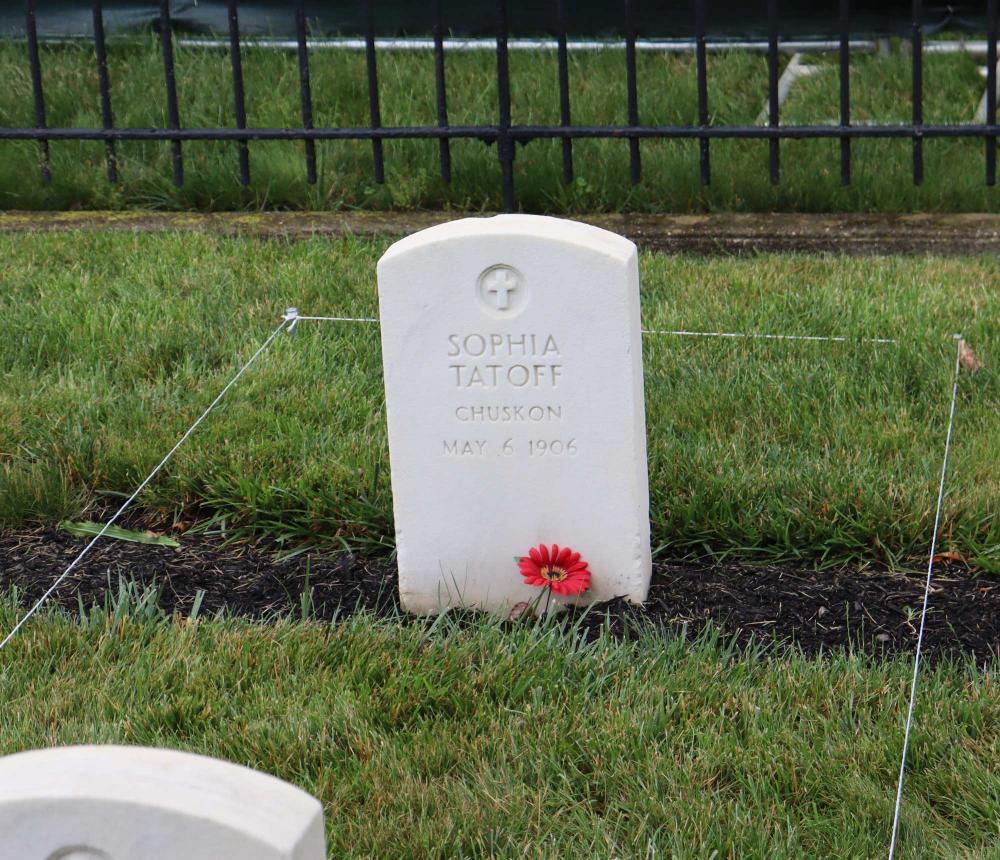
Per military custom, her former headstone there will be destroyed and the plot returned to green space.
“I was glad we went,” said Andrew Peters, who — after his experience — is considering going to medical school and practicing medicine one day in a rural Native community. “It was great to see our grandmother’s birthplace and meet the other Alaska Natives,” he said. “We could not have done it without them.”
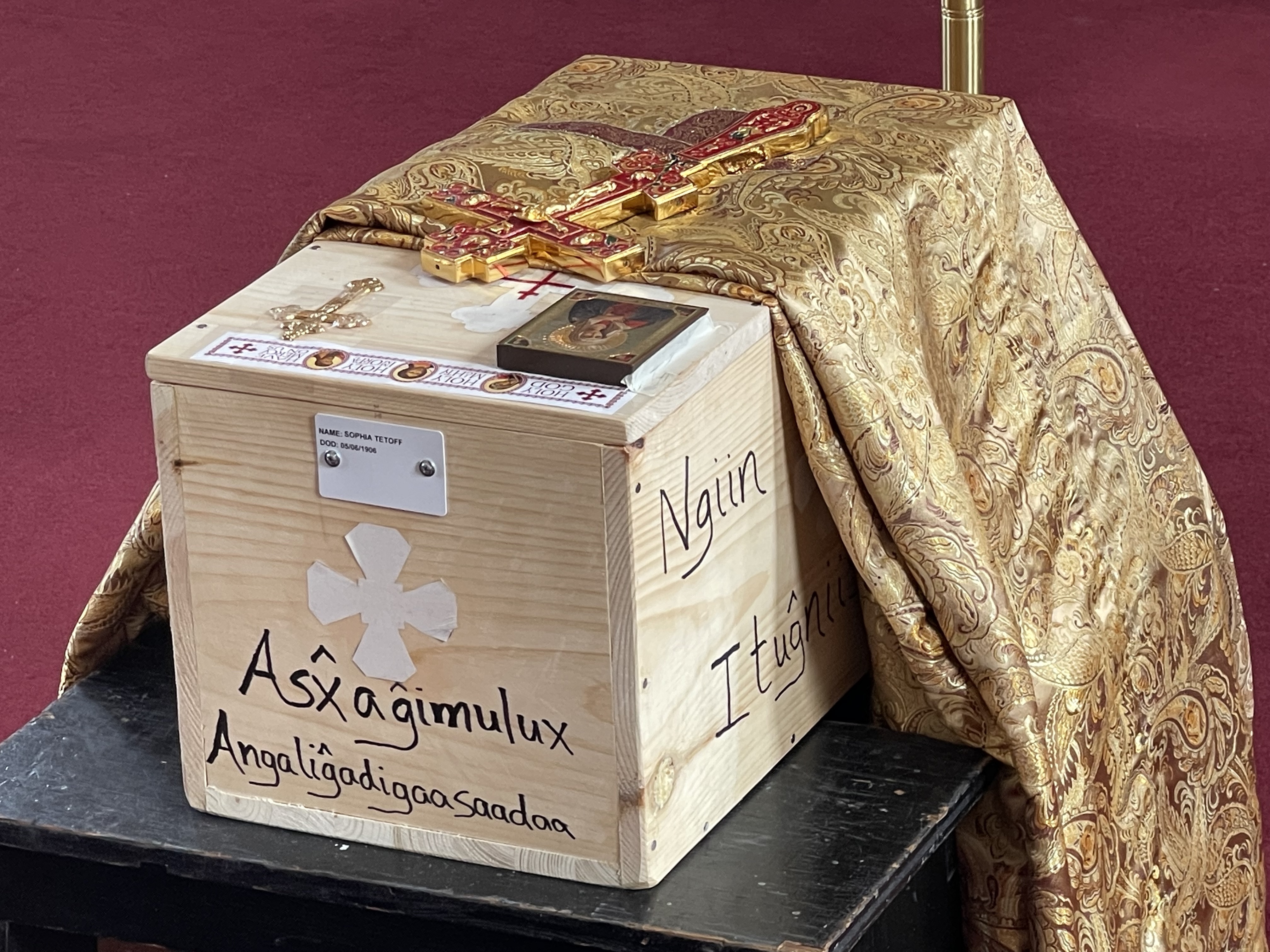
Locating orphans
Finding an orphan can be difficult. The estimated 100,000 or more children placed in these schools were often given other names, or buried in unmarked or incorrectly marked graves. Cemeteries have moved. Lauren Peters presumes many are missing and will never be found.
“No one even knew she existed,” she said about Sophia, who actually was buried with the wrong name on her headstone and the wrong tribe name. “It’s a wonder we found her.”
Sophia’s Return: A Mellon Public Scholar Project
Lauren Peters was selected to be a 2021 Mellon Public Scholar for her project, Sophia’s Return. As a Mellon Public Scholar, Lauren completed a spring seminar with 11 other cohort members, co-taught by Stephanie Maroney, MPS program manager, and Erica Kohl-Arenas, associate professor in American studies and faculty director of Imagining America, in preparation to carry out this summer project with a community partner. Peters is a former commercial pilot with a bachelor’s degree in economics from Mills College and a master’s degree from San Jose State University in information science.
As part of her studies at UC Davis, Peters is documenting the Alaska Native children buried in boarding school cemeteries across the United States. Her research started a few years back when she was looking into the history of internment camps during World War II, when Aleut were sent to broken-down canneries in Southeast Alaska.
She was selected in 2021 to participate in one of the Robert Wood Johnson Foundation’s leadership programs, Health Policy Research Scholars. This is a four-year program that offers training in health policy translation, dissemination, communication, health equity and population health.
In fact, she said she learned about Sophia by happenstance, doing research with her tribe. She got a call from a tribal elder looking for information on lost girls from the islands off Alaska’s southern coast who had been students in Carlisle. He mentioned one named Tetoff. “That is my family name,” she told him.
She had never heard of a Sophia, and neither had anyone in the family. The quest to find and return Sophia began.
As she put together the family story, Lauren Peters learned Sophia and her sister, Irene, were orphaned on St. Paul Island in 1895 and taken by Methodist missionaries, John and Mary Tuck, aboard the Bear to the Jesse Lee Home for Children on Unalaska Island. In 1900, Irene died in the “Great Sickness,” a measles and influenza epidemic brought on by the Yukon Gold Rush, and Sophia was sent to the Carlisle school.
From 1879 to 1918 more than 8,500 students were transported to Pennsylvania to be enrolled there, according to the Carlisle Historical Society. The school closed in 1918.
Andrés Reséndez, a UC Davis professor of history and author of the critically acclaimed book The Other Slavery: The Uncovered Story of Indian Enslavement, said the schools were a later form of colonialism, and their legacy is a sad one.
“Native Americans have suffered from the ravages of forcible removal since the early days of colonialism when they were captured, enslaved and shipped to distant workplaces,” explained Resendéz, a scholar of the colonialism of the Americas. “By the Civil War era, U.S. military officers like Colonel James H. Carleton regularly referred to the ‘Indian problem’ that he proposed solving by violently moving tribes into reservations.
“Indigenous boarding schools constituted a later iteration of a longstanding pattern of displacement, in this case of Native children, that lasted for centuries,” — Resendéz
Now, volunteers, universities, Native tribes and even the U.S. government are involved in an atonement process involving locating, identifying and returning these children from cemeteries at or near these schools to their birth homes.
Starting in summer 2017, repatriations of remains began when requested by descendants and families. These repatriations, organized by the U.S. Army, are ongoing, according to the Carlisle Indian School Digital Resource Center at Dickinson College.
The Army paid for the travel expenses of returning Sophia’s body to Alaska, as well as the Peterses’ expenses. Lauren Peters noted the irony of this expense. “She will be the first of many to return home to Alaska,” Peters pointed out. “I would guess that the costs today far outweigh the financial burden of two small girls on St. Paul Island 126 years ago.”
But she is sanguine about what has resulted.
“In all this darkness of stolen children, I marvel in how meaningful Sophia’s short life was and how many people she has touched,” Peters said. “She is introducing me and my sons to the island where my mother was born.”
A time of celebration
On the July Fourth weekend, the Peters family, including Lauren, Andrew and Lucas, 19, went to St. Paul Island from Sacramento to Seattle to Anchorage to Cold Bay for refueling — where, incidentally, Peters’ grandfather had built the runway — to St. Paul Island.
When Sophia’s body arrived a few days later, her coming home was a celebration of the entire community of St. Paul Island, where 90 percent of the inhabitants are Unangax.

Amid July Fourth celebrations — a carnival, and the celebration of the feast of St. Peter and St. Paul in the Russian Orthodox church — a large halibut feast for the whole community was prepared in honor of Sophia’s arrival, and there was much singing of Native songs.
The event was promoted in the community, including on the Aleuts’ Facebook page and in the Anchorage Daily News. “…As our entire community welcomes Sophia back to St. Paul, we honor her memory and promise to protect her legacy to the Aleut people and to the state of Alaska,” said Amos Philemonoff Sr., president of the Aleut Community of St. Paul Island Tribal Government on the tribe’s Facebook page.
How others can retrieve a lost child
According to Lauren Peters, the process to have your child returned is simple and straightforward. Tribes and families that would like to track members who may have attended Carlisle can be found on a database that is maintained by Dickinson College. The database can be searched by name, tribe, and other subject headings, including the cemetery and student records. Further information and contact information is available through the Carlisle Indian Industrial School Digital Resource Center.
The affidavit forms that the Army can provide need to be notarized and then sent to the Army Cemeteries Division. After acknowledging receipt, the Army begins the process for returning and reburying remains. The Army will reimburse travel costs and pay for costs associated with the funerals.
Sophia’s arrival was followed by a community parade through town, a stop at the Peters family house on the island, and a traditional funeral liturgy celebrated in Russian Orthodox and the Native language of Unangam Tunuu (Aleut) and English, languages Sophia eventually would have spoken, Lauren Peters said. Sophia would have spoken Aleut at home and Russian in the church. English was learned at the Jesse Lee Home and at Carlisle, Peters explained.
Andrew Peters, again, carried her to the cemetery. Lucas Peters carried the 8-foot-tall Orthodox cross that would adorn her grave. The entire community then filled in the gravesite with soil. Wildflowers, gathered along the way, were placed by the parade of people gathered.
“Everything there is done as a community,” Lauren Peters said. “It was quite heartwarming.”
While on St. Paul Island, Lauren Peters was able to meet with tribal historians and finally correct the records of her family, inserting Irene and Sophia into both the family and tribal history on the island. As part of her doctoral studies, she said she hopes to create a best practice for all families seeking to rematriate their lost children.
Andrew Peters added he was grateful to the island for welcoming them and bringing the family together again with Sophia’s burial — a once-in-a-lifetime experience for him but perhaps a starting point for other families.
“I’d like to think we started something.”

Media Resources
Resources:
- Carlisle Indian School Digital Resource Center, Dickinson College (Cemetery Information)
- Carlisle Indian School Project
- The Washington Post: “More Than Century Later, Disinterment Starts a Native American Girl Toward Home” (June 26, 2021)
- KQED Forum: “Grappling With the History of Native American Boarding Schools in California and Beyond,” interview with Lauren Peters and others
- The New York Times: “Lost Lives, Lost Culture: The Forgotten History of Indigenous Boarding Schools” (July 19-20, 2021)
- Capitol Public Radio Insight “Indigenous Orphan Returns Home More Than a Century Later” (Oct. 12, 2021)
Media Contact:
- Karen Nikos-Rose, UC Davis Media Relations, kmnikos@ucdavis.edu; 530-219-5472
Credits:
- Videography courtesy St. Paul Island Productions, edited and produced by Alysha Beck, UC Davis Office of Strategic Communications
- Historic photos of the Carlisle Indian Industrial School in this story and accompanying video courtesy of the Library of Congress and Dickinson College.
